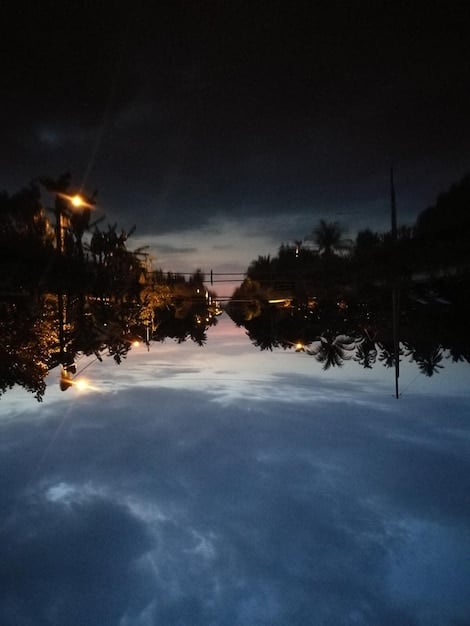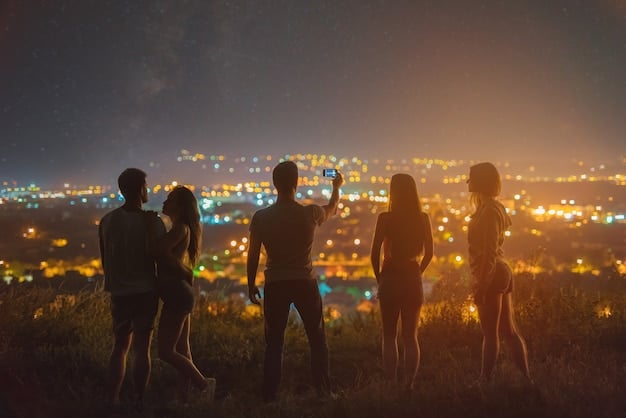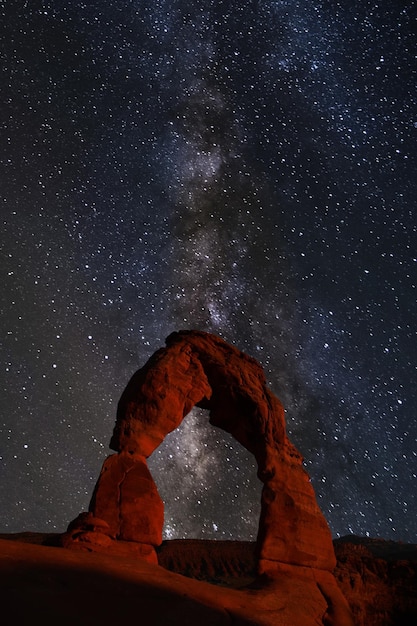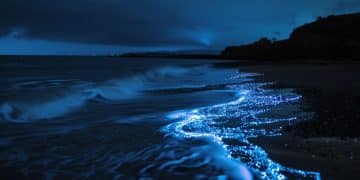Stargazing in the US: Dark Sky Parks for Clear Night Views

Exploring the Wonders of the Night Sky: A Guide to Stargazing in Dark Sky Parks Across the US unveils the magic of celestial observation in locations preserved for their dark skies, offering optimal conditions for appreciating the cosmos’ beauty.
Imagine gazing up at a sky ablaze with stars, far from the glare of city lights. This dream becomes reality when exploring the wonders of the night sky: A guide to stargazing in Dark Sky Parks across the US. These protected havens offer unparalleled views of the cosmos, inviting you to discover the universe.
What are Dark Sky Parks and Why Visit?
Dark Sky Parks are areas recognized for their exceptional commitment to preserving natural darkness. They offer unparalleled opportunities for observing celestial wonders and escaping light pollution’s disruptive effects.
Visiting a Dark Sky Park offers more than just stargazing; it’s an immersive experience. You’ll connect with nature, appreciate the delicate balance of ecosystems, and understand why darkness preservation is crucial.
The Importance of Dark Skies
Light pollution is an increasing threat, obscuring our view of the night sky and disrupting wildlife patterns. Dark Sky Parks actively combat light pollution through responsible lighting policies and community outreach.
- Protecting nocturnal wildlife and their habitats.
- Reducing energy consumption and carbon footprint.
- Providing educational opportunities and inspiring awe.
What You Can Expect at a Dark Sky Park
Expect minimal artificial light, panoramic views, and often educational programs. Many parks offer guided stargazing sessions, astronomy workshops, and interpretive exhibits.
Remember to check each park’s website for specific rules, regulations, and any observing events scheduled during your visit.

Ultimately, a visit to a Dark Sky Park allows you to appreciate the splendor of our universe, reminding us of the world’s vast scope beyond our artificial environments.
Cherry Springs State Park, Pennsylvania: A Stargazer’s Paradise
Cherry Springs State Park is renowned for its exceptionally dark skies, making it a prime destination for avid stargazers and astronomers. It provides a serene escape from urban light pollution.
Located in rural Pennsylvania, Cherry Springs offers a unique experience to observe the Milky Way in unparalleled clarity. Here’s a brief guide to planning your visit:
Planning Your Visit
The park is open year-round, but conditions vary. Summer months offer warmer weather; however, nights can be clearer and provide better visibility during the colder months.
- Check the weather forecast to ensure clear skies.
- Make reservations for camping or lodging in advance.
- Bring warm clothing, even in the summer, as temperatures can drop at night.
What to See at Cherry Springs
The Milky Way is prominently visible, along with numerous constellations and planets. The park also hosts star parties and astronomy programs to enhance your experience.
During darker nights, you might catch the faint glow of distant galaxies or occasional meteor showers. Check out the park’s official events schedule for more organized viewing sessions.
Cherry Springs State Park is an ideal place to witness a sky full of stars, offering a unique experience for both seasoned astronomers and casual observers.
Arches National Park, Utah: Stargazing Among Red Rocks
Arches National Park offers a stunning combination of natural arches and crystal-clear night skies. The contrast of red rock formations under a blanket of stars makes for unforgettable stargazing.
Stargazing at Arches provides a unique experience due to the park’s geographical features and dedication to dark sky preservation. Here’s some guidance for first-time visitors:
Best Spots for Stargazing
Popular spots include Balanced Rock, the Windows Section, and Panorama Point. These locations offer wide-open views with minimal obstruction from the surrounding terrain.
- Arrive early to secure your spot and allow time to explore the area.
- Use red light headlamps to preserve night vision and minimize light pollution.
- Familiarize yourself with the park’s regulations regarding nighttime activities.
Stargazing Events at Arches
The park occasionally hosts ranger-led stargazing programs. Check the park’s website for dates and times, and be sure to register in advance, as spaces are limited.
These events are a great way to learn about constellations, planets, and the importance of dark skies, enhancing the overall experience of stargazing at Arches.

Arches National Park merges geological wonders with heavenly views, creating a unique stargazing experience where the Earth and sky meet in breathtaking harmony.
Death Valley National Park, California: A Desert Sky Experience
Death Valley National Park, known for its extreme landscapes, also boasts some of the darkest skies in the United States. Its remote location and minimal light pollution make it a haven for stargazers.
Exploring Death Valley at night offers an otherworldly experience, highlighting the immense scale of both the desert and the cosmos. Here’s what you need to know to make the most of your nocturnal visit:
Tips for Night Exploration
Ensure your safety by informing someone of your plans, carrying plenty of water, and wearing appropriate clothing. Cell service can be unreliable, so plan accordingly.
- Use stargazing apps to find constellations and planets.
- Check the moon phase for optimal dark sky conditions.
- Attend ranger-led programs to learn about the night sky.
What to Observe
The Milky Way stretches across the sky from horizon to horizon. You might also spot zodiacal light, a faint glow caused by sunlight scattering off dust particles in our solar system.
Occasionally, transient celestial events like meteor showers and comets provide additional astronomical attractions, further enhancing the stargazing experience in Death Valley.
Death Valley National Park provides a unique stargazing experience where the vast, silent desert meets the boundless universe, creating a memory etched in both landscape and sky.
Big Bend National Park, Texas: Dark Skies on the Border
Big Bend National Park, located along the U.S.-Mexico border, is one of the most remote and least-visited national parks, offering exceptionally dark skies due to its isolation.
Stargazing at Big Bend provides a secluded experience, away from urban light pollution. It presents a vivid display of stars and cosmic phenomena. Here are some pointers for planning your night:
Where to Stargaze in Big Bend
Popular spots include the Chisos Basin, Santa Elena Canyon, and Sotol Vista. These areas offer expansive views and accessibility for both casual observers and serious astronomers.
- Consider camping within the park to maximize your stargazing time.
- Respect the park’s guidelines regarding lighting and noise levels at night.
- Prepare for varying temperatures—desert nights can be surprisingly cool.
Astronomical Events and Programs
Big Bend occasionally hosts star parties and educational programs conducted by park rangers and astronomy enthusiasts. These events often feature telescopes and guided tours of the night sky.
Such programs offer valuable learning opportunities, enhancing stargazers’ understanding of cosmic phenomena and promoting appreciation for the park’s pristine nocturnal environment.
Big Bend National Park stands as a testament to dark sky preservation, offering visitors a chance to reconnect with the cosmos in a setting of unparalleled natural beauty and tranquility.
Acadia National Park, Maine: Coastal Stargazing
Acadia National Park offers a unique opportunity for coastal stargazing, combining the beauty of the Atlantic coastline with dark, clear skies. Located in Maine, it provides a different perspective from the desert parks in the West.
Stargazing at Acadia is truly special due to the park’s varied landscapes and commitment to dark sky conservation. Consider these tips to optimize your visit:
Prime Spots Along the Coast
Popular locations are Sand Beach, Otter Point, and Cadillac Mountain. These offer unobstructed views of the sky over the Atlantic Ocean and surrounding islands.
- Dress warmly, as coastal areas can be cold and windy, even in summer.
- Arrive before sunset to enjoy the scenic views before nightfall.
- Participate in ranger-led nighttime programs for an enriched experience.
What to See Above the Waves
Beside the Milky Way, you may spot satellites and occasional meteor showers, combined with the sound of waves crashing against the shore.
Northern Lights, though infrequent, are an added spectacle on certain nights, enhancing the overall experience of stargazing from Acadia’s uniquely beautiful coastal setting.
| Key Aspect | Brief Description |
|---|---|
| 🌌 Dark Sky Parks | Areas with minimal light pollution, ideal for stargazing. |
| 🔭 Equipment | Binoculars or telescopes enhance your viewing experience. |
| 📅 Best Times | New moon nights offer the darkest skies. |
| 🔦 Safety | Use red lights to preserve night vision. |
“`html
## FAQ
▼
A Dark Sky Park is an area recognized for its exceptionally dark skies and commitment to preserving them by minimizing light pollution and promoting responsible lighting practices.
▼
Bring warm clothing, a red light flashlight to preserve night vision, binoculars, a star chart or stargazing app, and a comfortable chair for extended viewing periods.
▼
The best time for stargazing is during a new moon, when the sky is at its darkest. Check the moon phases and weather forecasts to plan your trip accordingly.
▼
Dark Sky Parks combat light pollution through regulations on outdoor lighting, community education programs, and collaborations with local governments to promote responsible lighting practices.
▼
Entrance fees depend on the specific park. National Parks typically charge an entrance fee, while some state parks or reserves may be free. Check the park’s official website for details.
“`
Conclusion
Exploring the wonders of the night sky in Dark Sky Parks across the US provides a unique opportunity to connect with nature and the universe. These protected havens offer unparalleled views of celestial wonders, free from light pollution. Whether in Pennsylvania, Utah, California, Texas or Maine, each of these destinations promises an unforgettable stargazing experience.





